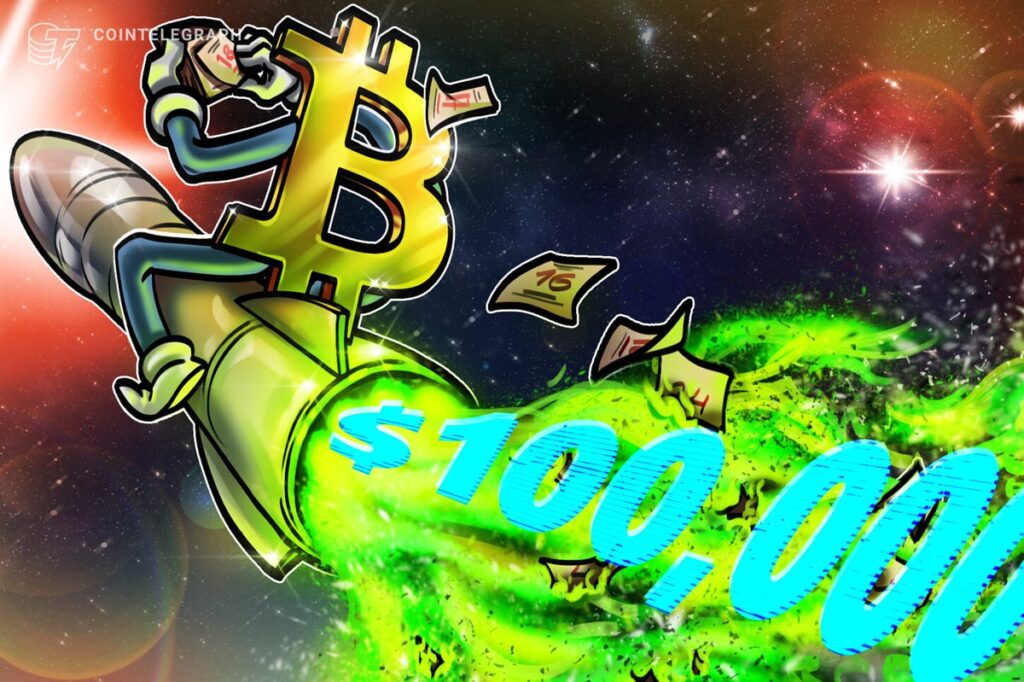Bitcoin has reached the historic $100,000 milestone almost 16 years after launching in 2009 — but the road hasn’t been easy for OG Bitcoiners, who have had to endure some of the most brutal attacks from mainstream media’s (MSM) biggest names.
Media coverage of Bitcoin (BTC) started slowly picking up around the time its pseudonymous creator, Satoshi Nakamoto, vanished from Bitcoin talk boards in 2011.
It caught the attention of the likes of Forbes, The New York Times, The Washington Post, Bloomberg, and CNN — publishing mostly negative stories, which has, without a doubt, significantly influenced society’s perception of Bitcoin (BTC) today.
The ratio of positive Bitcoin stories has, however, increased as Bitcoin soared to new highs and became more institutionalized in the early 2020s, according to Bitcoin Perception data shared exclusively with Cointelegraph.
Split of neutral, negative or positive crypto-related stories from MSM since 2013. Source: Bitcoin Perception
Here are some of MSM’s most brutal headlines and comments that Bitcoiners were faced with on the road to $100,000.
“So, that’s the end of Bitcoin then” — Forbes in 2011:
Forbes prematurely called the end of Bitcoin when its price fell from “$17 to pennies in a matter of minutes” in June 2011.
The price collapse was triggered by one trader attempting to sell more Bitcoin than cryptocurrency exchange Mt. Gox could absorb.
Forbes incorrectly called the end of Bitcoin in 2011. Source: Forbes
The former Forbes opinion writer Tim Worstall claimed Bitcoin wasn’t liquid or secure enough to be a medium of exchange or a store of value — a semi-plausible opinion at the time that looks far less plausible now.
Bitcoin’s price then: $17
Satoshi Nakamoto’s anonymity a “huge red flag” — CNN in 2013
Many critics couldn’t fathom the idea that Bitcoin could be secure with an off-the-radar pseudonymous creator, including former CNN opinion writer James J. Angel, who strongly believed Satoshi Nakamoto’s unknown identity made Bitcoin a “huge red flag.”
“I would certainly not trust my life savings to some mysterious computer algorithm created by shadowy anonymous characters in a system that attracts underworld types.”
Like many others, Angel didn’t like how Bitcoin transactions offer a degree of anonymity, claiming it makes an ideal currency for “tax evaders, drug dealers and terrorists.”
Angel’s views are less commonly held in 2024 as transactions on Bitcoin are publicly visible and can be investigated by blockchain forensics firms like Chainalysis and TRM Labs, which work closely with law enforcement to catch criminals.
Bitcoin’s price then: $17
Bitcoin may be “legitimate” after all — Bloomberg in 2013
There were times, albeit rare, when Bitcoin was seen in a better light. As Bitcoin soared from $12 to around $900 in 2013, more financial experts invited on mainstream media brought a loud and clear message: Bitcoin is “legitimate.”
One of those experts was Nick Colas, a founder at DataTrek Research, who championed Bitcoin’s security, predictable monetary supply and ability to transact across borders in a 2013 interview with Bloomberg.
Nick Colas spoke to Bloomberg about Bitcoin’s potential in 2011. Source: Bloomberg
In 2014, The Washington Post interviewed Marc Andreessen, a founder at software-focused venture capital firm a16z, who bullishly predicted that Bitcoin would become as influential as the internet by 2034.
Bitcoin’s price then: $142
Satoshi is like a “reckless” doctor overprescribing drugs — Financial Times in 2014
A former risk examiner at the United States Federal Reserve criticized Satoshi for building a poorly designed Bitcoin supply schedule that doesn’t account for the “ebbs and flow” of economic cycles.
“Nakamoto’s writings seem to indicate that the motivation, at least in part, was the libertarian ideal of putting money creation beyond the reach of meddling central bankers.”
“But this is a mistake,” Mark Williams said.
“It ignores the ebbs and flow of economic cycles – a reckless approach that is the equivalent of a doctor giving penicillin to every patient without first checking whether they are suffering from infection, depression or mania.”
Opinion piece from Mark Williams claiming Bitcoin has several design flaws. Source: Financial Times
Williams praised Bitcoin as a technological invention but feared it would undermine central banks as it showed people that “currency could be nationless.”
Central banks are tasked with controlling the money supply and interest rates while preventing runaway inflation to spur economic growth, but Bitcoin aims to take these roles away and give it to an algorithm instead, Williams said.
“The software behind Bitcoin is a remarkable technical achievement but those who tout such systems as a way of saving capitalism are profoundly wrong.”
Bitcoin’s price then: $672
Bitcoin is an “energy glutton” that could harm Earth’s climate — The Washington Post in 2018
MSM then turned to criticize Bitcoin for its high energy consumption as the network’s hashrate increased to over 50 exahashes per second (EH/s) in September 2018.
The Washington Post referred to Bitcoin as an “energy glutton” — something that uses excessive or greedy indulgence — in an October 2018 report, which cited data suggesting that Bitcoin’s greenhouse gas emissions were already comparable to those of a midsize country.
“It could catapult the planet to dangerous levels of warming if it continues its rapid growth,” The Washington Post said from the research.
Bitcoin’s hashrate has since soared to nearly 800 EH/s, of which approximately 54.5% is sourced from renewable energy.
Bitcoin’s price then: $6,332
Bitcoin is too cumbersome, slow, expensive to use — The New York Times in 2021
MSM started pointing to network congestion and high fees once Bitcoin’s user base and transaction count soared in 2020 and 2021.
Bitcoin has become too “cumbersome, slow, and expensive to use,” Cornell University Professor Eswar Prasad said in an opinion piece titled “The Brutal Truth About Bitcoin” in June 2021.
“It is as though your $10 bill could buy you a beer on one day and a bottle of fine wine on another.”
“It has no intrinsic value and is not backed by anything,” Prasad added.
Opinion piece from Eswar Prasad arguing Bitcoin is problematic. Source: The New York Times
Prasad further claimed Bitcoin might “exacerbate inequality” rather than democratize finance as sophisticated, financially literate investors would reap benefits early on while the less well-off take on risks they don’t fully comprehend.
Bitcoin’s price then: $40,218
Bitcoin ETFs approved, but think before jumping on the “bandwagon” — CNN in 2024
Following the approval of the Bitcoin ETFs in January, CNN cautioned investors to think twice before buying Bitcoin ETFs, sharing commentary from investment advisers who suggested steering clear of the products or allocating 3% to their portfolios at the very most.
CNN said those considering jumping on the “bandwagon” should understand they would be investing in an asset that has a “new wrapper” but carries “many of the same risks” — like market manipulation and volatility.
Bitcoin’s price then: $46,368
The Economist also claimed the Bitcoin ETFs were “off to a bad start” three weeks later when Bitcoin retraced to $42,500, and outflows from Grayscale’s Bitcoin Trust ETF (GBTC) were running rampant.
Related: Bitcoin price will hit $1M, but at what cost? — Michaël van de Poppe
These remarks were made around the time when BlackRock’s iShares Bitcoin Trust was recording more inflows than 99.8% of ETFs in the US — far exceeding industry expectations.
Fast-forward nearly 10 months, inflows into the Bitcoin ETFs excluding GBTC are $47 billion, contributing significantly to Bitcoin’s meteoric price rise from around $46,200 to now over $100,000.
“So Long As Bitcoin Is The Noisy Price Story, It Won’t Ever Be Money” — Forbes in 2024
Forbes contributing writer John Tamny noted that a continued rise in Bitcoin’s price would make it impossible for it to become a widely used currency as Satoshi initially envisioned.
“Money is just the reasonably trusted store of value that moves production between buyer, seller, lender, and borrower,” so why would a “Bitcoin cheerleader” use Bitcoin as a medium of exchange when they think it’s going up, Tamny pondered in a Nov. 17 Forbes article.
”If you agree with the present narrative that bitcoin’s surge is of the early days variety then you’re by definition accepting what’s similarly true, that bitcoin will never be money.”
Bitcoin’s price then: $89,895
Many industry pundits tip Bitcoin to notch its next $100,000 far quicker than the first $100,000 was reached.
Will that finally change the minds of mainstream media’s opinion writers? History says probably not.
Magazine: Asian crypto traders profit from Trump’s win, China’s 2025 CBDC deadline


